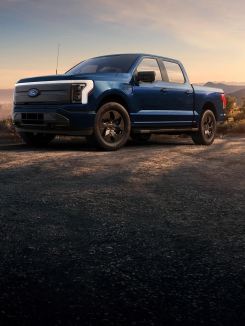Welcome to Digital Trends' weekly summary of the groundbreaking technology that is enabling, linking, and now propelling advanced electric vehicles.
Monterey Car Week, featuring its highlight event The Quail: A Motorsports Gathering, has evolved into the automotive industry's most exclusive stage. Here, the wealthiest individuals and bold designers showcase concept cars that appear to come straight from science fiction. However, during the same week, Ford announced a different kind of innovation: a $30,000 midsize electric pickup truck, developed using a new software-designed platform with a compact battery, intended to support a range of affordable electric vehicles. This serves as a reminder that although luxury remains captivating, accessible EV technology is not only feasible but also approaching rapidly.
Innovative Designs on the Green
At the Quail, manufacturers revealed eye-catching displays that exist somewhere between cinematic props and futuristic automobiles.
· Cadillac’s Elevated Velocity reimagined the concept of luxury and practicality with style: gullwing doors; striking 24-inch wheels; and features such asTerra for off‑road, Elements Defyremoving shaking particles from the body, andSand Visionfor improved visibility during dust storms—enclosed within cabin features such as red-light therapy and a "waterfall" screen integrated into the steering wheel.
 · Karma Automotive left a strong impression with itsKaveyasuper-coupe and "GT-UV" concept—featuring a fully functional interior, carbon-fiber frame, and a powerful 1,000 hp electric powertrain.
· Karma Automotive left a strong impression with itsKaveyasuper-coupe and "GT-UV" concept—featuring a fully functional interior, carbon-fiber frame, and a powerful 1,000 hp electric powertrain.
· A wave of ultra‑luxuryand performance electrics also made their mark: from Rimac's 2,107-hp Nevera Rhypercar (price: ~$2.5 million), toAcura’s RSX prototype, driven by an internally developed EV platform and highlighting Honda’s e:Architecture, which is set to enter production soon. Not to mention Mercedes-AMG's visionary approachConcept GT XXfeaturing 1,341 hp from three axial-flux motors, a groundbreaking performance design.
Amidst this display of opulence, these vehicles showcase the pinnacle of electric vehicle technology: speed, elegance, and innovative design—yet remain inaccessible to the majority.
Ford's "Model-T Era" Comes to Life
Now examine the opposite side of the scale: Ford's courageous declaration regarding a $30,000 midsize electric pickup truck, developed on a software-defined vehicle platform, caused a shared reaction—not because of its main price, but due to its consequences.
This 'universal EV Platform' features a compact, cost-effective LFP (lithium-iron-phosphate) battery, reduced components, and a design built to generate afamily of cost‑efficient models. Beyond merely constructing a pickup truck, Ford is indicating the emergence of **integrated electric vehicle technology**, where advanced software, battery control, and large-scale manufacturing efficiency come together.
Unsurprisingly, Ford CEO explicitly framed the moveAs a technological and pricing battle with BYD—China's leading electric vehicle company recognized for its cost-efficient batteries and platform economies. Ford's strategy directly challenges the global supremacy of budget-friendly EVs coming from Asia, combining scale, simplicity, and local battery manufacturing to lower costs and compete effectively.

Ford's next generation of electric vehicles will be designed as software-defined cars, where their essential systems—ranging from performance adjustments to entertainment and battery control—will be managed through integrated software platforms. Similar to a smartphone, they will get over-the-air (OTA) updates, allowing Ford to add new features, boost efficiency, improve safety, and resolve issues without needing a visit to the service center.
This idea initially came to life in 2012 when Tesla implemented OTA updates in its Model S, establishing a new benchmark for connected car technology. In the subsequent years, Chinese electric vehicle startups NIO and XPeng adopted comparable software-focused designs, introducing their own vehicles with OTA capabilities around 2018. By 2021, American electric vehicle companies Lucid and Rivian also embraced the software-driven approach, highlighting the move away from the conventional, hardware-focused method of vehicle development.
Currently, SDVs are becoming more widely used throughout the industry. For drivers, this implies owning a more flexible and forward-thinking vehicle—one that can change and improve over time. Car manufacturers can remotely modify vehicle performance, enhance range predictions, upgrade entertainment systems, and even add new features after the vehicle has been purchased. This also opens the door to customized experiences and subscription-based services, allowing owners to access upgrades or customize their vehicle's digital setup as needed.
Two Worlds. One Future.
What stands out is the tension—and the coming together—of these narratives.
On one hand, Monterey's lawn showcases what's truly bold: solar concepts, high-end interiors, extreme performance, AI-powered cabins, and striking power designs. On the other hand, Ford presents a more subdued, yet potentially groundbreaking shift: electric vehicle technology integrated into affordability, not as an added feature, but as its main focus. Software-defined platforms allow for updates, performance improvements, safety enhancements, and user features to be upgraded without needing new hardware—a look at how mass-market EVs can progress quickly.
This is more than a technological dream. It indicates that electric vehicle solutions for the general public are becoming more refined. The deep combination of affordable battery technology, simplified component design, and software-driven management systems is what makes an affordable electric vehicle possible—not only for wealthy enthusiasts, but for regular households.
Latest Technology News, Sent to Your Email